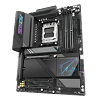 13
13
Gigabyte X870E Aorus Pro Review
(13 Comments) »Value and Conclusion
- Gigabyte X870E Aorus Pro is currently listed online for $350
- Attractive design
- Plenty of expansion possibilities
- Good layout
- Good M.2 and VRM temperatures
- Tool-free M.2 ports and heatsinks
- M.2 heatsinks can be fiddly to install
- Only one PCIe Gen 5 M.2 port that doesn't steal bandwidth
- Limited benefits over X870 and B850 boards
- EFI not quite as polished-feeling as the competition
- No noteworthy accessories
The Gigabyte X870E Aorus Pro has an attractive design with minimal RGB lighting but plenty of attention to detail on its heatsink aesthetics to make this a head-turner of a motherboard. There's no doubt that it has the features to offer a home to all the components you'd want to install in a high-end gaming or content creation PC too as well as offering the usual perks of a current generation AMD motherboard, such as dual USB4 ports, Wi-Fi 7, PCIe Gen 5 support for graphics cards and SSDs. We don't think many will be left wanting from its specifications, except maybe if you need more than four SATA ports or want to use multiple PCIe Gen 5 SSDs. Even with the former you have additional PCIe Gen 4 and Gen 3 slots for expansion cards.
There are plenty of other great inclusions too. You get power and reset buttons, an LED POST code display, two thermistor inputs for thermal probes, heatpipe-linked VRM heatsinks and even an HDMI port at the front of the board for powering case screens. You'll be able to tap into higher speeds and power on the front panel Type-C port too thanks to USB 3.2 Gen 2x2 support. Being a somewhat premium board in the current generation, you get all the latest EZ features that make building your PC easier too, such as tool-free M.2 ports and heatsinks across all ports, a PCIe push-button release and screwless single-piece WI-Fi antenna.
Then of course you have to consider whether you actually need an X870E motherboard. There may be features aside from additional bandwidth that tempt you, but ultimately, the main reason you should be considering this board is the ability to power multiple M.2 SSDs and offer several PCIe slots, with only a minimum of bandwidth sharing. Admittedly, that comes at the expense of part of one of its headline features in PCIe Gen 5 M.2 support, given two of its three PCIe Gen 5 M.2 ports share bandwidth with your graphics card, but you can still use the top slot and a PCIe Gen 4 SSD at the same time with no cost to your graphics card in addition to having additional PCIe slots for further expansion too.
Looking higher up the food chain, and you'll get the option to use multiple PCIe Gen 5 SSDs at the same time, front panel Type-C ports with uprated power capabilities, boosted aesthetics including more RGB lighting and uprated CPU power delivery. A lot of that will be superfluous to most users, but the Gigabyte X870E Aorus Pro finds itself somewhere between the more affordable $200-250 boards than can handle a single PCIe Gen 5 SSD and those aforementioned ones that will leave a sizeable dent in your wallet, for example the ASUS ROG Crosshair X870E Hero or the X870E Aorus Master, which currently costs around $110 more.
At more affordable price points, the drop isn't nearly as bad as it is from say $250 to around $200. There you start to see many features heavily downgraded or even vanish entirely such as USB4, USB 3.2 Gen 2x2, EZ features, adequate cooling for PCIe Gen 5 SSDs with downgrades to audio codecs fairly common. Compared to the likes of the Gigabyte X870 Aorus Elite Wi-Fi 7 or MSI MAG B850 Tomahawk Max Wi-Fi that both offer $100 or more in savings, the Gigabyte X870E Aorus Pro struggles to justify its higher price tag, especially compared to its cheaper Aorus sibling, which really only loses out on RGB lighting, a couple of layout-related niggles and extra PCIe bandwidth, but realistically anyone with a graphics card and up to two M.2 SSDs, so long as one of those is PCIe Gen 4 or slower, won't have any need for that extra bandwidth.
The Gigabyte X870E Aorus Pro builds on the solid platforms that are its lower end X870 models, offering a decent specification for the price and significantly undercuts more premium models we're fond of including the ASRock X870E Taichi and MSI MPG X870E Carbon Wi-Fi. However, those boards offer more wow factor, while the Gigabyte X870E Aorus Pro doesn't really do the same compared to the boards that sit well below it. As a result the likes of the Gigabyte X870 Aorus Elite Wi-Fi 7 are much better value unless the increased PCIe bandwidth provided by this X870E-equipped board and the expansion options that provides are dealbreakers.

There are plenty of other great inclusions too. You get power and reset buttons, an LED POST code display, two thermistor inputs for thermal probes, heatpipe-linked VRM heatsinks and even an HDMI port at the front of the board for powering case screens. You'll be able to tap into higher speeds and power on the front panel Type-C port too thanks to USB 3.2 Gen 2x2 support. Being a somewhat premium board in the current generation, you get all the latest EZ features that make building your PC easier too, such as tool-free M.2 ports and heatsinks across all ports, a PCIe push-button release and screwless single-piece WI-Fi antenna.
Then of course you have to consider whether you actually need an X870E motherboard. There may be features aside from additional bandwidth that tempt you, but ultimately, the main reason you should be considering this board is the ability to power multiple M.2 SSDs and offer several PCIe slots, with only a minimum of bandwidth sharing. Admittedly, that comes at the expense of part of one of its headline features in PCIe Gen 5 M.2 support, given two of its three PCIe Gen 5 M.2 ports share bandwidth with your graphics card, but you can still use the top slot and a PCIe Gen 4 SSD at the same time with no cost to your graphics card in addition to having additional PCIe slots for further expansion too.
Looking higher up the food chain, and you'll get the option to use multiple PCIe Gen 5 SSDs at the same time, front panel Type-C ports with uprated power capabilities, boosted aesthetics including more RGB lighting and uprated CPU power delivery. A lot of that will be superfluous to most users, but the Gigabyte X870E Aorus Pro finds itself somewhere between the more affordable $200-250 boards than can handle a single PCIe Gen 5 SSD and those aforementioned ones that will leave a sizeable dent in your wallet, for example the ASUS ROG Crosshair X870E Hero or the X870E Aorus Master, which currently costs around $110 more.
At more affordable price points, the drop isn't nearly as bad as it is from say $250 to around $200. There you start to see many features heavily downgraded or even vanish entirely such as USB4, USB 3.2 Gen 2x2, EZ features, adequate cooling for PCIe Gen 5 SSDs with downgrades to audio codecs fairly common. Compared to the likes of the Gigabyte X870 Aorus Elite Wi-Fi 7 or MSI MAG B850 Tomahawk Max Wi-Fi that both offer $100 or more in savings, the Gigabyte X870E Aorus Pro struggles to justify its higher price tag, especially compared to its cheaper Aorus sibling, which really only loses out on RGB lighting, a couple of layout-related niggles and extra PCIe bandwidth, but realistically anyone with a graphics card and up to two M.2 SSDs, so long as one of those is PCIe Gen 4 or slower, won't have any need for that extra bandwidth.
The Gigabyte X870E Aorus Pro builds on the solid platforms that are its lower end X870 models, offering a decent specification for the price and significantly undercuts more premium models we're fond of including the ASRock X870E Taichi and MSI MPG X870E Carbon Wi-Fi. However, those boards offer more wow factor, while the Gigabyte X870E Aorus Pro doesn't really do the same compared to the boards that sit well below it. As a result the likes of the Gigabyte X870 Aorus Elite Wi-Fi 7 are much better value unless the increased PCIe bandwidth provided by this X870E-equipped board and the expansion options that provides are dealbreakers.

May 5th, 2025 21:06 EDT
change timezone
Latest GPU Drivers
New Forum Posts
- It's happening again, melting 12v high pwr connectors (1070)
- WD Black or Gold for Gaming (10TB) (43)
- Vertical mice in gaming (24)
- Ventoy how to copy iso to the Ventoy drive? (2)
- Post Your TIMESPY, PCMARK10 & FIRESTRIKE SCORES! (2019) (315)
- Game Soundtracks You Love (1057)
- 9070XT Nitro vs Taichi? (14)
- 3DMARK "LEGENDARY" (316)
- What's your latest tech purchase? (23710)
- Windows 11 General Discussion (6028)
Popular Reviews
- Arctic Liquid Freezer III Pro 360 A-RGB Review
- ASUS Radeon RX 9070 XT TUF OC Review
- Clair Obscur: Expedition 33 Performance Benchmark Review - 33 GPUs Tested
- ASUS ROG Maximus Z890 Hero Review
- Zotac GeForce RTX 5070 Ti Amp Extreme Review
- Upcoming Hardware Launches 2025 (Updated Apr 2025)
- Seasonic Vertex GX 850 W Review
- Sapphire Radeon RX 9070 XT Nitro+ Review - Beating NVIDIA
- ASUS GeForce RTX 5090 Astral Liquid OC Review - The Most Expensive GPU I've Ever Tested
- Montech HS02 PRO Review
Controversial News Posts
- AMD Radeon RX 9060 XT to Roll Out 8 GB GDDR6 Edition, Despite Rumors (131)
- NVIDIA Sends MSRP Numbers to Partners: GeForce RTX 5060 Ti 8 GB at $379, RTX 5060 Ti 16 GB at $429 (128)
- NVIDIA Launches GeForce RTX 5060 Series, Beginning with RTX 5060 Ti This Week (115)
- Nintendo Confirms That Switch 2 Joy-Cons Will Not Utilize Hall Effect Stick Technology (105)
- NVIDIA PhysX and Flow Made Fully Open-Source (95)
- Sony Increases the PS5 Pricing in EMEA and ANZ by Around 25 Percent (84)
- Parts of NVIDIA GeForce RTX 50 Series GPU PCB Reach Over 100°C: Report (78)
- Intel "Bartlett Lake-S" Gaming CPU is Possible, More Hints Appear for a 12 P-Core SKU (77)